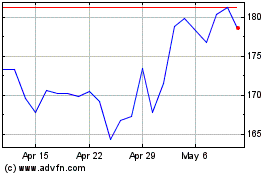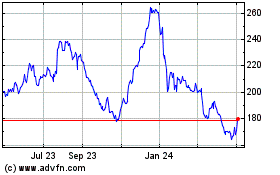By Aresu Eqbali in Tehran, Rory Jones in Dubai and Georgi Kantchev in Kyiv
Iran blamed human error for the shooting down of the Ukrainian
airliner that crashed outside of an airport in Tehran, attempting
to limit the fallout from its initial denial, as Kyiv demanded
justice and compensation for the 176 people on board who died.
Iranian officials had initially denied claims by Western
officials that the Boeing Co. 737-800 single-aisle jet was downed
by a missile system fired by Iran, possibly by mistake.
The Ukraine International Airlines jet crashed Wednesday four
hours after Iran had launched military strikes against the U.S. in
Iraq in retaliation for the killing of a top general, and the
Middle Eastern state was on high alert for a potential U.S.
response.
A junior officer made a mistake, Brig. Gen. Amir Ali Hajizadeh,
commander of Iran's Revolutionary Guard's Aerospace Force, told
Iranian state television Saturday while explaining the
incident.
Gen. Hajizadeh, who oversees most of Iran's missile arsenal,
also sought to insulate the country's political leadership from any
criticism at home and abroad. He said missile-system operators were
told to fire at U.S. or other enemy warplanes without seeking
permission from senior commanders.
Ukrainian President Volodymyr Zelensky said Kyiv expects Tehran
to punish those responsible.
"This wasn't a good morning, but it brought the truth," Mr.
Zelensky said in a Facebook post. "We expect from Iran assurances
of a full and open investigation, bringing those responsible to
justice, the return of the bodies of the dead, payment of
compensation [and] official apologies through diplomatic
channels."
The downing of the jet, which killed dozens of Iranians, is
likely to place further pressure on Iran's leadership, already
challenged by U.S. sanctions that have prompted an economic crisis
and widespread public protest.
It is also facing possible international isolation as the U.S.
intensifies the sanctions pressure on Iran in a bid to limit its
nuclear program and what Washington says is Tehran's regional
interference. The two sides in recent days pulled back from the
brink of war after Iran targeted U.S. forces in Iraq to avenge the
killing of Maj. Gen. Qassem Soleimani. Since the Iranian strikes,
President Trump has said the U.S. didn't plan to respond to Iran
and that Iranian forces appeared to be standing down from further
conflict with American forces.
Iran's move to publicly disclose the mistake of shooting down
the jet reflects an attempt to maintain its international
credibility, particularly with European countries, many of whom are
trying to provide it relief from sanctions and keep the 2015
nuclear deal alive. Relations with France, Germany and Britain have
strained in recent months as Iran has stepped away from its deal
commitments.
Iranian President Hassan Rouhani tweeted that the downing was a
"great tragedy & unforgivable mistake."
Gen. Hajizadeh attempted to explain why Iran, until Saturday,
had repeatedly denied the plane was shot down by a missile. Iranian
investigators had said the jet likely crashed due to a technical
error, as the pilot was attempting to return to Tehran's main
international airport when it hit the ground.
"The aviation authorities assumed that if a missile hits a
plane, it should explode in the air," Gen. Hajizadeh said. "One of
our forces has made the mistake and because it's under our command,
the responsibility is on us."
Iran's prosecutor general, Mohammad-Jafar Montazeri, in a
directive to Tehran's military prosecutor, demanded "swift,
meticulous" investigations to identify all the causes and
individuals involved in the incident, according to the semiofficial
ISNA news agency.
The Iranian acknowledgment rules out the role of any mechanical
issue with the plane resulting in the disaster. That will lessen
the importance of an international investigation, which was just
starting to take shape, seeking to make initial conclusions about
what brought the jet down.
The stakes were especially high for Boeing, the maker of the
737-800 jet that was shot down. Already embattled on many fronts
over the grounding of its newer 737 MAX plane, the company risked
further reputational damage had there been any question of
mechanical issues with the Ukrainian jet.
Ukraine International Airlines said Saturday that the flight was
cleared for takeoff because it received no warning from the Tehran
airport, pointing to other international flights that departed
around the same time. It said that the plane had not veered off its
normal course.
A senior airline official blamed Iran for not closing the
airport due to escalation of tensions in the region.
"It was absolutely irresponsible... if you're playing war, you
are obliged to close the airport," Ihor Sosnovskiy, the airline's
vice president for operations, told reporters.
Also on Saturday, Iranian investigators said they would send the
so-called black-box data to France for analysis after determining
that Iran doesn't have the necessary technology to assess the
data.
It remains unclear if an international investigation would now
be pressed. Iranian officials had invited investigators from
Boeing, the U.S., Ukraine, France and Canada to probe the causes of
Wednesday's crash, which killed a number of Canadians. Boeing
started preparing the necessary paperwork and has been in touch
with both the State and Commerce departments, The Wall Street
Journal reported Thursday.
For Iran, the crash comes after a convulsive few months. At
least 59 people died this week in a stampede at a funeral march for
Mr. Soleimani, the military commander killed by a U.S. strike.
In November, hundreds of demonstrators were killed by security
forces, according to rights groups and Iran-based opposition media,
when they rose up across the country in protest against government
austerity measures, prompted partly by American sanctions. The
security response was the deadliest in decades.
The Ukrainian jet isn't the first time tensions between the U.S.
and Iran have led to an aviation tragedy. In 1988, the U.S. Navy's
Vincennes warship downed Iran Air Flight 655 with an air-defense
missile.
U.S. officials said they mistook the Airbus SE A300 airliner for
a warplane they feared would attack the ship. All 290 people,
mostly Iranian, on the plane died, prompting an outpouring of
national grief in Iran.
Write to Rory Jones at rory.jones@wsj.com and Georgi Kantchev at
georgi.kantchev@wsj.com
(END) Dow Jones Newswires
January 11, 2020 08:41 ET (13:41 GMT)
Copyright (c) 2020 Dow Jones & Company, Inc.
Boeing (NYSE:BA)
Historical Stock Chart
From Mar 2024 to Apr 2024

Boeing (NYSE:BA)
Historical Stock Chart
From Apr 2023 to Apr 2024
